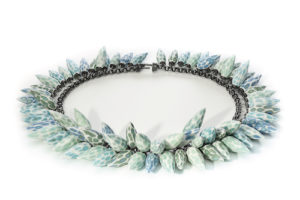Since ancient times, ceramics and glass have been associated with extraordinary artwork. Approximately 30,000 years ago, clay-based statuettes were formed to represent animals and religious figures, whereas later dated pottery was produced not only to hold liquids (e.g., water, wine, and oil) and food, but also to illustrate stories and provide pictures of ancient life. Mosaics made with colored pieces of glass and stones became widespread during classic Greek and Roman times.
Over the centuries, the popularity of ceramics and glass in art has evolved and expanded into various forms, and, under many aspects, ceramic and glass art has also become more functional.
Pottery is the most inexpensive and widespread type of ceramic art. It continues to be associated with local cultures, representing patterns and shapes of significance to the people living in a certain area, and often clearly identifying the region of origin. For example, Native American vases are typically characterized by relatively simple geometric patterns rarely using more than four colors. Sometimes, animals and flowers are pictured, but almost never human beings.
Italian pottery is well known for its vibrant colors and often the painted images suggest what it should be used for: lemons and grapes for fruit-based dishes, the writing “Biscotti” for cookies, and so on. The pottery comes in different shapes and sizes (e.g., salt and pepper shakers, oil and vinegar dispensers, pitchers, coffee cups, trays, and candle holders), and can be functional or just be used for decoration.
The Chinese are famous for their fine white porcelain adorned with blue detailed images of intertwining flowers, plants, and dragons. Chinese porcelain is mostly used for vases that come in all different sizes and shapes, as well as for dishes and bowls.
Artists have learned to use ceramics to create the most unusual objects. In addition to decorative pots, vases and tableware, figurines and sculptures are also made. In fact, clay- and concrete-based ceramics are quite easy to form into virtually any type of shape and they can be painted with various techniques (e.g., flat enamels, glossy or matte finish, and milk paint) to achieve the most outstanding effects. Lately, 3D printing has been introduced as an aid for artists to experiment new forms and create prototypes in a short time. Alison Britton, Roxanne Swentzell, Steven Young Lee, Kyungmin Park, Arlene Shechet, and Ron Nagle are just some of the contemporary artists that have become well-known for their works of art based on ceramics.
Another form of ceramic art is tile mosaic. It consists of combining colored tiles to create paintings. Tiles can be of different dimensions and shapes and they act as the pixels of the image. Mosaic art can actually be two- or three dimensional, with the former being the most popular.
Glass also has an important place in art. Glass art includes three-dimensional shapes, stained glass, glass mosaics, paintings on glass, and hanging glass.
Other applications of ceramics and glass in art include beads and small items found in jewelry and to repair and preserve art objects in conservation science.
The American Ceramic Society publishes magazines, videos, and other resources for the art ceramics community through its Ceramics Arts Network (CAN). Ceramics Monthly focuses on clay and contemporary culture from the artist's perspective, while Pottery Making Illustrated relates new techniques and tools to practicing and aspiring potters. For those who prefer video presentations, CAN produces CLAYflicks Streaming, a video subscription service.
The main types of ceramic and glass art are illustrated in the table below.
| Type | Examples |
|---|---|
| CERAMICS | |
| Pottery | 1  |
| Figurines | 2  |
| Sculptures | 3  |
| 2D Mosaics | 4  |
| 3D Mosaics | 5  |
| Jewelry | 6  |
| Tiles | 7  |
| GLASS | |
| 3D shapes | 8  |
| Stained glass | 9  |
| Mosaics | 10  |
| Paintings on glass | 11  |
| Hanging glass | 12  |
| Jewelry | 13  |
| Conservation glass (used for framing artwork and for presenting art objects in a display box) | 14  |
Image credits: 1. Dawn Candy’s Ash Leaf Cream and Sugar Set, wheel thrown with slip-trailed decoration, underglaze, glaze (Courtesy of Pottery Making Illustrated); 2. Beth Katleman’s Hostile Nature, 8 ft. (2.4 m) in length, cone 10 porcelain, wire, chain, 2013. Photo: Malcolm Varon (Courtesy of Ceramics Monthly); 3. Beth Cavener’s The Question that Devours, 5 ft. 3 in. (1.6 m) in height, stoneware, paint (Courtesy of Ceramics Monthly); 4. Segment of Canada 150 Mosaic, 10 ft. (3 m) in width, white cone-6 stoneware, 2017. Photo: Preston Gervais (Courtesy of Ceramics Monthly); 5. Max Pixel; 6. Peter Hoogeboom’s Mokume Gane Taiwan Pine, (from the series Greenware, Crockery, Chinawear), 11 ¼ in. (29 cm) in diameter, 2014 (Courtesy of Ceramics Monthly); 7. Jason Green’s Shift, 6 ft. 7 in. (2 m) in length, terra-cotta tiles, slip, glaze (Courtesy of Ceramics Monthly); 8. Pixabay; 9. Pixabay; 10. Colleen M, Flickr; 11. Cooking Cinderella, Flickr; 12. Pixabay; 13. Pixabay; 14. Zde, Wikimedia
Join The American Ceramic Society
Become an ACerS member and enjoy the additional benefits of belonging to a global community of ceramic and glass scientists, researchers, materials scientists, professors, students, and manufacturers.
